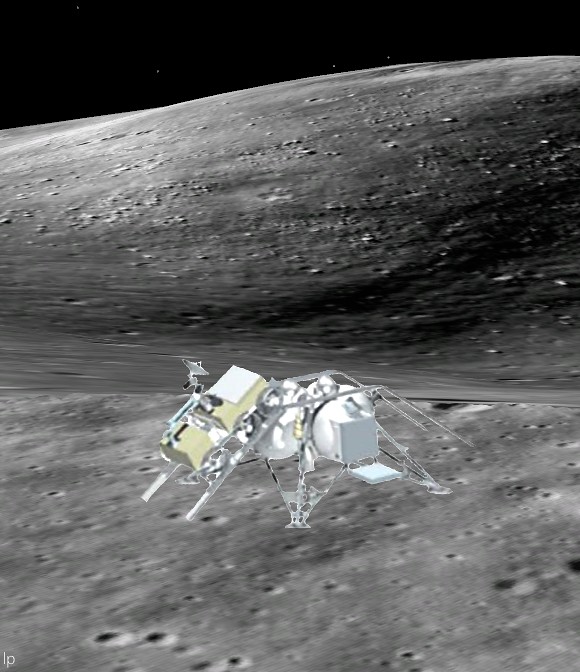The Indian Space Research Organisation (ISRO) is out to be first in the unofficial competition to soft-land near the Moon's south pole when Chandrayaan-2 eventually flies, according to Anil Bhardwaj, director of the space physics laboratory at Vikram Sarabhai Space Centre (VSSC) in Trivandrum.
Bhardwaj made the claim when presenting the P.R. Pisharody Memorial Lecture at the Kerala Science Congress in Alappuzha, the three day science conference adjourning Thursday.
India's national space agency was already first to crash-land a vehicle designed for that purpose near the Moon's south pole.
On November 14, 2008 the Moon Impact Probe (MIP), after launch in tandem with Chandrayaan-1 aboard the indigenously-developed PSLV rocket and insertion into polar orbit around the Moon, was deliberately impacted into the permanently shadowed interior of Shackleton crater, while capturing photographs and directly detecting sublimating water before impacting near 89°S, 330°E.
The 18 month mission of Lunar Prospector was similarly concluded as an afterthought in 1999, within the permanently dark interior of a crater close to the Moon's south pole, a crater eventually named for the American astrophysicist who came up with the idea.
It was Gene Shoemaker (1928-1997), a director of the Surveyor lunar lander program ahead of the Apollo era who suggested using the mission-ending impact of Lunar Prospector in a long-shot attempt to toss up and remotely detect volatile compounds, including water, that were thought trapped in the permanently shadowed regions of the Moon's poles after the Clementine mission in 1994.
Finer data on neutron suppression at the lunar surface collected over the first few months of the Lunar Reconnaissance Orbiter (LRO) mission lead NASA to select Cabeus crater for the deliberately targeted dual impacts of LCROSS and it's trailing Shepherding vehicle, October 9, 2009.
Bhardwaj said success with Mangalyaan, the on-going Mars Orbiter Mission (MOM), has confirmed ISRO refinements in India's ambitious space infrastructure has made a long-planned Chandrayaan-2 mission more cost-effective.
On November 14, 2008 the Moon Impact Probe (MIP), after launch in tandem with Chandrayaan-1 aboard the indigenously-developed PSLV rocket and insertion into polar orbit around the Moon, was deliberately impacted into the permanently shadowed interior of Shackleton crater, while capturing photographs and directly detecting sublimating water before impacting near 89°S, 330°E.
The 18 month mission of Lunar Prospector was similarly concluded as an afterthought in 1999, within the permanently dark interior of a crater close to the Moon's south pole, a crater eventually named for the American astrophysicist who came up with the idea.
It was Gene Shoemaker (1928-1997), a director of the Surveyor lunar lander program ahead of the Apollo era who suggested using the mission-ending impact of Lunar Prospector in a long-shot attempt to toss up and remotely detect volatile compounds, including water, that were thought trapped in the permanently shadowed regions of the Moon's poles after the Clementine mission in 1994.
Finer data on neutron suppression at the lunar surface collected over the first few months of the Lunar Reconnaissance Orbiter (LRO) mission lead NASA to select Cabeus crater for the deliberately targeted dual impacts of LCROSS and it's trailing Shepherding vehicle, October 9, 2009.
Bhardwaj said success with Mangalyaan, the on-going Mars Orbiter Mission (MOM), has confirmed ISRO refinements in India's ambitious space infrastructure has made a long-planned Chandrayaan-2 mission more cost-effective.
Chandrayaan-2 has suffered a number of troubling delays, inspiring concern among ISRO fans throughout the world and push backs from an original target date in 2013.
The ultimate success of the indigenously developed GSLV-Mark III rocket booster added a 1000 kg capacity to the Chandrayaan-2; more than enough to make thoughtful redesigns worth initial delays.
Russia originally partnered with ISRO in the Chandrayaan-2 mission, to build a lander as ISRO designed and built orbiter and rover components for the project.
In August 2013, however, as a direct result of the 2011 failure of the Russian-led Fobos-Grunt sample-return mission to Phobos, Roscosmos added weight to their Chandrayaan-2 lunar lander design and effectively threw off balance plans already developed involving the GSLV and the other mission components.
Though Roscosmos offered India contingent space on-board Soyuz launches in 2015 and 2017, ISRO determined added risk together with added restrictions on the rover's design were more problematic than building their own lander.
Related:
ISRO Chandrayaan will go without Roscosmos (August 17, 2013)
Rogozin presses Russian lunar base, Chandrayaan-2 delayed
by Proton and Phobos-Grunt investigations (September 13, 2012)
Chandrayaan-2: ISRO Annual Report (April 26, 2012)
Chandrayaan-2 may miss 2013 launch date (February 21, 2012)
Luna-Resource and Chandrayaan-2 in 2013 (August 4, 2010)
A new lunar globe as seen by Chandrayaan M3 (April 7, 2010)
The ultimate success of the indigenously developed GSLV-Mark III rocket booster added a 1000 kg capacity to the Chandrayaan-2; more than enough to make thoughtful redesigns worth initial delays.
Russia originally partnered with ISRO in the Chandrayaan-2 mission, to build a lander as ISRO designed and built orbiter and rover components for the project.
In August 2013, however, as a direct result of the 2011 failure of the Russian-led Fobos-Grunt sample-return mission to Phobos, Roscosmos added weight to their Chandrayaan-2 lunar lander design and effectively threw off balance plans already developed involving the GSLV and the other mission components.
Though Roscosmos offered India contingent space on-board Soyuz launches in 2015 and 2017, ISRO determined added risk together with added restrictions on the rover's design were more problematic than building their own lander.
Related:
ISRO Chandrayaan will go without Roscosmos (August 17, 2013)
Rogozin presses Russian lunar base, Chandrayaan-2 delayed
by Proton and Phobos-Grunt investigations (September 13, 2012)
Chandrayaan-2: ISRO Annual Report (April 26, 2012)
Chandrayaan-2 may miss 2013 launch date (February 21, 2012)
Luna-Resource and Chandrayaan-2 in 2013 (August 4, 2010)
A new lunar globe as seen by Chandrayaan M3 (April 7, 2010)


1 comment:
Hi nice blog you have shared such a useful information regarding how to deal with
chandrayaan 2 keep writing.
Post a Comment